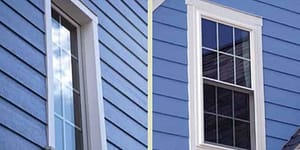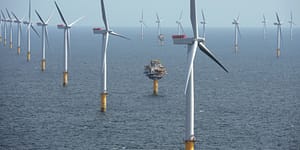Weatherproofing Your Windows: Preparing for Winter

Getting ready to pile on the blankets this winter? Warm up your home and increase efficiency this winter by weatherproofing or replacing your windows!
The following is an excerpt from The Greened Hour Effect by Jeff Wilson. It has been adapted for the web.
Weatherproofing Windows for Winter
Unfortunately, shopping for windows can be frustrating. The maze of technical specifications and marketing ploys can make your head spin, but if you start by thinking seriously about what the most desirable window would accomplish you’ll be on your way to making a sound decision.
New Construction vs. Replacement Windows
One major decision is whether to install new construction windows or replacement windows. New construction windows require removal of the old window, frame and all, before installation.
The upside of this is that it allows the installer to properly air seal and insulate between the new window frame and the rough opening of the home’s original structure.
Pros and Cons of New and Replacement Windows
A new construction window also affords the opportunity to add flashing materials to discourage water intrusion. Replacement windows require removal of the sashes only; the windows are then installed within the existing window frames.
The new glass of the replacement window will improve the thermal properties of the glass itself, but any air leaks between the old frame and the home’s structure will still be present.
Thus, new construction windows will provide better energy efficiency because they can be properly integrated into the building envelope by sealing and insulating between the edges of the window frame assembly and the framing of the house.
Weatherproofing Windows: U-Value
First, you want windows and doors that keep the heat in or out, depending on the season, so you want good thermal performance. This is typically expressed in doors as an R-value, just like in wall or roof insulation. With windows, it’s expressed as a Uvalue.
Why? Because that way it’s more confusing for homeowners, and window salesmen can pull the wool over their eyes more easily. What does that “U” stand for?
While the “R” in “R-value” stands for “resistance,” the “U” is simply a symbol that stands for overall heat transfer. Simply put, U-value is the inverse of R-value (U=1/R).

The “Super Spacers” in Pro Via triple pane windows are made of low-thermal bridging foam, not metal. illustration courtesy of pro via.
What These Values Mean
That means, whereas high R-value is important in wall insulation, low U-values are important in windows. Lower U-values are achieved in windows by using multiple panes of glass with empty spaces between them. That space is usually filled with argon or krypton gas.
Double pane, gas-filled windows are common, but triple pane windows are also available, boosting thermal performance.
Triple pane windows can cost 20 to 25 percent more than similar double pane windows, so making sure that you’ll benefit from choosing triple pane windows is important before you break the bank over them.
Keeping Climate In Mind
If you live in a very cold climate and have a home with lots of windows, triple pane, gas-filled windows can help save you significant amounts of energy (and, triple pane windows are more comfortable to sit next to on a cold winter night than double pane windows—which may be a benefit worth paying for).
Even the type of gas— argon or krypton, typically—will have an effect on thermal performance. Make sure to get a second (or third) opinion before buying triple pane windows, and be sure to get those opinions from someone who is not trying to sell them to you.
This is a great question for your trained home energy auditor, who has the tools necessary to help quantify the savings of one type of window over another.
Window Weatherproofing: Frame Considerations
The way in which glass panes are mounted in a window frame is important, too. Traditionally, metal spacers are inserted between the panes of glass.
Metal is an excellent thermal conductor, so heat is easily wicked through the edge of the interior solid glass pane, through the metal spacer, into the exterior solid glass pane, and to the outdoors.
In the wintertime, this leads to a “cold edge” on the glass pane that often causes warm, humid interior air to condense near the edges of the window panes. This condensation often results in water beading up and running down the panes onto the frame.
Wooden Window Frames
If the window frame is made of wood, it can become damp, which can lead to expansion. When the wood dries again, it contracts. Over time, this can lead to cracking of the wood and/or mold and mildew growth. In extreme conditions, the wood eventually rots and fails altogether.
This “cold edge” problem led to the development of foam and butyl spacers that inhibit the conduction of heat between the panes. Called “warm edge” technology, it helps to avoid condensation and heat transfer through the spacer, extending the life of the window and making it even more energy efficient than a comparable window with metal spacers.
Frame Types
Frame type has an effect on how a window functions from an energy efficiency standpoint. While wood windows may have an aesthetic appeal, they have drawbacks, including somewhat higher thermal conduction and sensitivity to moisture, like the cold edge condensation mentioned earlier.
Metal or metal clad windows might solve some of the moisture problems, but they still suffer from high thermal conductivity.
Vinyl or fiberglass window frames, especially frames that are insulated, offer the best in energy efficiency, low maintenance, and stability over time, due to the fact that they resist both thermal conduction and moisture.
They also never need painting, so that’s one little job you can permanently delete from your “honey do” list.
Emissivity
The amount of sunlight that radiates through a window (or indoor heat that radiates out) affects the protective qualities of the window, too.
Weatherproofing in Hot Climates
In hot climates, the amount of sunlight allowed in can be controlled by adding a “low-e” (short for low emissivity) coating to the outside of a window pane. This coating, applied in the manufacturing process, blocks a certain amount of light from entering the house and also helps prevent radiant heat from transferring from a warmer pane to a cooler pane.
That helps keep the window’s U-value lower and stops a certain amount of the sunlight entering a house from hitting an interior surface and warming it. This keeps indoor air temperatures cooler so the air-conditioning has to work less to keep the space cool.
Weatherproofing in Cold Climates
In cold climates, the low-e coating can be applied to the interior of a window pane to block heat from radiating out from the inside. Different low-e coatings can be applied to windows that face different compass directions, customizing them for lots of sun on the south side of a house, or much less on the north.
The Solar Heat Gain Coefficient (SHGC) of a window is a measure of how much solar heat is transmitted through the window. If you live in a hot climate, you’ll want a lower SHGC so that less heat enters your home.
If you live in a cold climate, you’ll want a higher SHGC so that more solar heat can enter your home. The extra heat gain during winter months can help offset some of your home’s heating costs. In either case, the coatings can also limit the visual light that is transmitted, meaning a severely tinted window, which has a low SHGC and admits little in the way of solar heat, may also look too “dark.”
 Fixed vs. Operable Windows
Fixed vs. Operable Windows
Finally, think about which windows need to open and close and which can be fixed. A fixed pane window, with no operable parts, will naturally keep air movement at bay, while operable windows that rely on seals and latches to prevent air movement when they’re closed will be more susceptible to air leakage.
Types of Operable Windows
Those operable windows come in two basic types: casement/crank windows and sash/double-hung windows. Good quality casement windows have a single latch that controls several mechanical arms along the length of the window.
When the latch is pulled down, the window is cinched tightly against the foam rubber gasket in several places, ensuring a tight air seal. Double-hung sash windows are designed to slide in a track.
A foam rubber seal in the track isn’t feasible because the window would catch against the rubber when moved. So even when tightly latched shut, double-hung sash windows won’t have the high-quality air seal of casement windows.
Benefits of Operable Windows
You’ll want enough operable windows in your home to take advantage of good weather when you have it. I like to have operable windows in all rooms, but not all of the windows in a room need to operate. A window with access partially blocked by a nearby appliance or piece of furniture may work best as a fixed pane window.
Properly placed operable windows can help in cross-ventilation, which can help to cool your home without turning on an air conditioner. Consider, too, that operable windows can be used as emergency exits. Everyone will have a different plan and preference.
Considerations While Weatherproofing
As you weigh all these factors, keep in mind that saving money in the short term by buying stock windows from a big box home improvement store—with its well-meaning but potentially less knowledgeable staff—could end up costing you money in the long run.
Many of the better window brands are available only via wholesale to professional installers who have been certified by the manufacturers as competent in proper installation.
When you buy high-quality windows, you’ll also gain access to professionals who can help design a whole-house solution for your window needs, weighing all of the options available. Keep that in mind—paying more for professional-grade windows is likely worth the investment.
Recommended Reads
Recent Articles
Looking for a new way to enjoy the benefits of your garden all year long? Follow this easy tutorial for making drying trays to expand the lifespan of fruits, vegetables, and herbs. The following is an excerpt from Preserving Food Without Freezing or Canning by The Gardeners & Farmers of Terre Vivante. It has been adapted for…
Read MoreGetting ready to pile on the blankets this winter? Warm up your home and increase efficiency this winter by weatherproofing or replacing your windows! The following is an excerpt from The Greened Hour Effect by Jeff Wilson. It has been adapted for the web. Weatherproofing Windows for Winter Unfortunately, shopping for windows can be frustrating. The…
Read MoreThe new threshold for green building is not just low energy, it’s net-zero energy. In The New Net Zero, sustainable architect Bill Maclay charts the path for designers and builders interested in exploring green design’s new frontier net-zero-energy structures that produce as much energy as they consume and are carbon neutral. The following is an excerpt…
Read MoreScientists maintain that a mere 2 percent increase in the carbon content of the planet’s soils could offset 100 percent of all greenhouse gas emissions going into the atmosphere. But how could this be accomplished? What would it cost? Is it even possible? The following is an excerpt from Grass, Soil, Hope by Courtney White. It has been…
Read MoreAt the rate humanity is currently burning fossil fuels, we will create an uninhabitable earth long before we run out. So if the pressure of a finite resource doesn’t push us towards a renewable energy revolution, what will? And what will this revolution look like? This is an excerpt from A Small Farm Future by Chris…
Read More
 Fixed vs. Operable Windows
Fixed vs. Operable Windows






